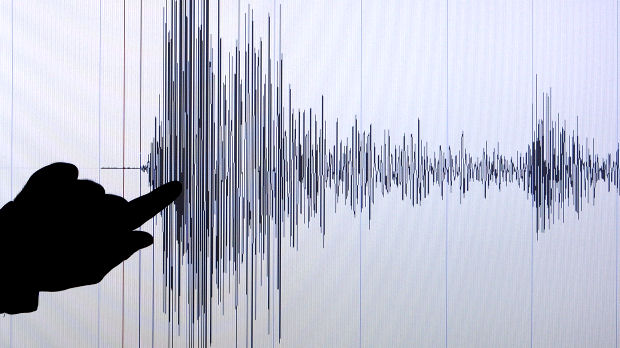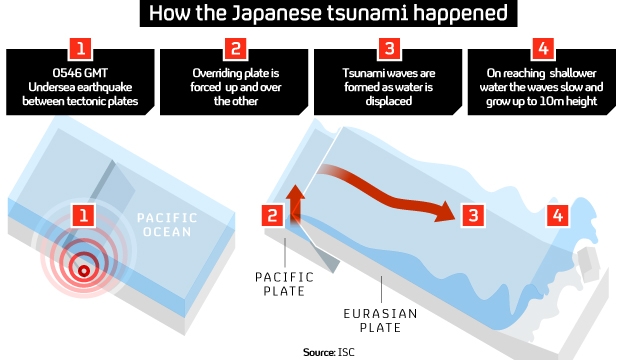Tsunami science: a wall of water
Not all earthquakes produce tsunamis. And the power of a seismic wave as it hits land depends on a whole range of factors. Channel 4 News looks at why tsunamis can be so devastating.

An earthquake is the release of built-up strain within the earth’s crust, usually in the boundaries between tectonic plates.
But not all earthquakes are the same. It depends on whether the relative movement between the plates is horizontal or vertical. With a horizontal shift or displacement, if you were standing on one side of the fault and looked across, you would see the other side move to your left or right.
In California, the movement between plates is typically horizontal (“strike-slip”). Although earthquakes there can cause devastation, they tend not to produce tsunamis – or “seismic sea waves”.
But the plate movement that caused the earthquake and tsunami off the north east coast of Japan was vertical – a “thrust” earthquake. That is to say, one plate of the earth’s crust moved upwards relative to the rest of the earth.
“I think it’s going to be an inter-plate event, where the Pacific plate is thrusting underneath the Asian plate and the boundary is to the east of Japan,” Professor David Tappin of the British Geological Survey told Channel 4 News.
“That’s where the thrust is – about 10-12 kilometres’ depth, which means it will have more of a seabed impact. The thrust will propagate up, so the vertical displacement will probably be greater at the seabed. That in turn means that the tsunami will be larger than if it was deeper.”
But any earthquake can have any combination of horizontal and vertical movement. It is in essence a three-dimensional displacement in the earth.
Only a bump?
So what happens to generate a tsunami after the vertical movement between plates? The movement produces a large displacement of water which creates a wall – an uplift of water above the earthquake.
“The water has to go somewhere,” explains Dr Wayne Richardson of the International Seismological Centre, “and it has to go at once. It’s not like a wave breaking at the beach. It’s a mass movement. It can travel, depending on the depth of the water, at up to 950 kilometres per hour (589mph) in the deep ocean.”
If you were in an ocean liner, you might only feel a bump when the tsunami went underneath. Dr Wayne Richardson
It is only when the tsunami approaches land that its height, or amplitude, begins to build. “When it travels at great speed, it doesn’t have a large amplitude – there’s not much to be seen,” says Dr Richardson. “But when it hits shallow water, the speed decreases and the amplitude grows.
“That’s why we don’t get a big wave in the middle of the ocean, but it’s travelling very fast. If you were in an ocean liner, you might only feel a bump, if you were lucky, as the tsunami wave passed underneath.”

‘You just can’t stop it’
How the tsunami behaves when it hits land is the consequence of a number of factors. “The size of the tsunami away from the epicentre will depend on how the wave propagates across the ocean, and that depends on the sea floor structure,” says Professor Tappin.
“But when it strikes land, the height of the wave will be dependent on local coastal topography. For example, if it’s in an inlet, then the energy could be focused and it could be dangerous. But I would stress that we don’t know what the effect of the tsunami in the ‘far field’ is yet.”
When it strikes land, the wave’s height is dependent on coastal topography. Professor David Tappin
One thing that is sure is that when the tsunami hits land, it is not the sort of wave you see at the beach. The 2004 Indonesia tsunami, in which hundreds of thousands died, was a solid wall of water, picking up debris and carrying that debris along with it. “You just can’t stop it. It just keeps going,” says Wayne Richardson.
‘Don’t run along, go up’
A major concern in relation to the 11 March tsunami is the devastation it could wreak on low-lying Pacific atolls such as Kirabati and Tuvalu. David Tappin, though, thinks it will be unusual if the tsunami there reaches more than a metre or two.
What is more, there is a detailed tsunami warning system in place. The United States established the Pacific Tsunami Warning Center in response to Hawaii’s susceptibility to seismic waves from throughout the Pacific. Many countries in tsunami-prone areas have also implemented local warning systems in order for people to evacuate from threatened areas.
And there are sensors around the Pacific, which detect the change in wave pressure created by the tsunami passing. These instruments provide information which forms the basis for computer modelling of the tsunami’s amplitude by the time it reaches, for example, the west coast of South America.
The message to threatened inhabitants is nonetheless not to ignore warnings and, in the event of a tsunami warning, to head towards higher ground. In Japan, which appears likely to bear the brunt of the casualties from this disaster, people are advised: “Don’t run along – go up.”